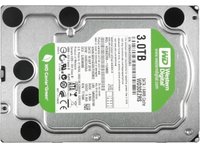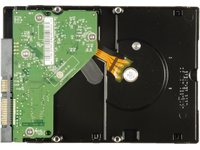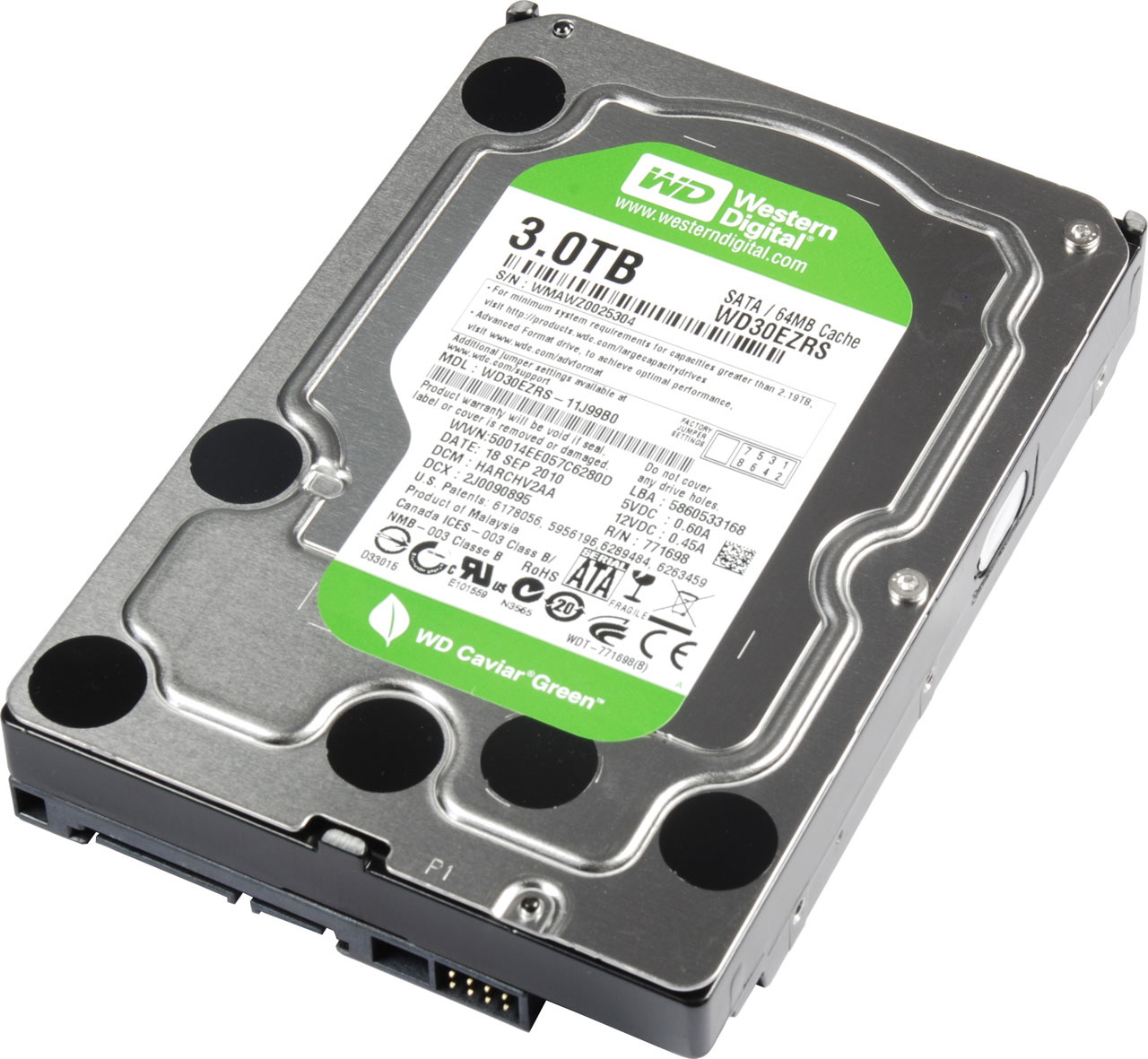Four 3 TB Hard Drives, Tested And Reviewed
Hard drives able to hold 3 TB of data need to be considered carefully because they might not always work as expected. This round-up of four high-capacity disks compares products from Hitachi, Seagate, and Western Digital, then covers their caveats.
Western Digital Caviar Green (WD30EZRS)
Western Digital is something of a pioneer in this story because its 3 TB was the first one available. Along with the previously-tested WD30EZRS, the manufacturer now provides the WD30EZRX, another drive with the same capacity. The only difference is the interface. While our test candidate uses a SATA 3 Gb/s interface, the WD30EZRX has twice the potential interface bandwidth at 6 Gb/s. Of course, as we all know, neither drive can even come close to saturating those links.
Both drives are part of the Caviar Green product line, which along with the 3 TB capacity comes in 2.5, 2, 1.5, 1, and .75 TB capacity points.
Yet again, we see another drive vendor playing the same game. Western Digital reveals nothing about the exact speed of the Caviar Green drives, just like Hitachi with its Deskstar 5K3000. Hitachi calls the feature CoolSpin, while Western Digital opts for IntelliPower. With these mechanisms, the hard drives spins at a rate that achieves the best balance of performance, noise level, and power consumption. Because the manufacturer promises that performance is in no way compromised by the IntelliPower function, you can assume that the speed is somewhere between 5400 and 6000 RPM, just like the Hitachi drive.
Performance
While the ED30EZRS makes no claims of stellar performance potential, it lives up to its stated purpose of quiet data storage. The device is by no means slow, though. Its average read throughput of 94 MB/s is nearly as fast as its most applicable competition, Hitachi Deskstar 5K3000. However, the high average access time of more than 20 ms and the comparatively low interface performance of 211.6 MB/s speak for themselves. The 7200 RPM drives (like Seagate's Barracuda XT) deliver results almost twice as fast. The Western Digital WD30EZRS also must yield to the competition when it comes to the application benchmarks.
If you're looking for a large drive for data storage or several disks for a NAS server, the Western Digital WD30EZRS is ideal. However, the competing Hitachi drive is worth its slightly higher price if you're planning to use it in large storage arrays. With an idle power consumption of 6.2 W, it uses almost 1 W less, putting it in the lead for performance per watt.


Get Tom's Hardware's best news and in-depth reviews, straight to your inbox.
Current page: Western Digital Caviar Green (WD30EZRS)
Prev Page Seagate Barracuda XT (ST33000651AS) Next Page Comparison Table And Test Setup-
agnickolov ReplyThree terabyte hard drives remain premium products, not only because they're best handled by enthusiasts who know what they're doing, but also because they're the largest disks available and you always seem to pay more for the largest, fastest, coolest...well, you know the drill.
Well, that's no longer the case:
http://www.tomshardware.com/news/GoFlex-Desk-4TB-3.5-inch-industrial-design-USB-3.0,13371.html
-
vdr369 Seagate barracuda is pulling my heart with it's performance, but punching my pocket with it's price,Reply -
salb99 the hitachi 5k3000 at max throughput uses less power than at idle, is it correct? also, video power consumptions here are the same as idle for all drives.Reply -
dww I don't see the point of 3 TB drives. Too big to use in most current systems, but too small to be a useful gain over 2 TB for those that CAN handle larger sizes. At present they're also too expensive, and once 4 TB drives come out in volume they'll be superseded. So I guess they're just a short term stopgap.Reply -
excidium Graph labels for the 7K3000 are incorrect ( 5400RPM ) on page:Reply
Benchmark Results: Throughput And Interface Bandwidth
Haven't finished reading the rest of the article. -
WD30EZRS recommended for NAS?Reply
how about TLER ? and the issue with frequent head parking ? Though the later is correctable with wdidle3.exe..
Considering each green drive might have different rotation speed are you sure about your NAS recommendation? -
monkeysweat i know 2TB is cheaper per GB,, however i only got 4 HDD slots in my case,, and 3 are in use already,, 1.5, 2.0 & 2.5 TB model drives + 1 SSD tucked under my card reader,, either i gotta spend more on a new case + drive or just spend a little more on a nice drive...Reply -
chesteracorgi With 2 Samsung 2.0 TB F4 Ecogreen (SATA 3.0 & 32 MB cache) and 2 1.5 TB Seagate Barracuda Green (SATA 6.0 & 64 MB cache) drives installed in my home server, it is my experience that HDDs are no better off on SATA 6.0 than on SATA 3.0. If you are looking for performance then look for a faster rpm rate: the 640 GB WD Caviar Black (SATA 6.0 & 64 MB cache) kills all of the above in speed. However, none of these HDDs can touch an older generation SSD like the Crucial C300 (128 GB).Reply
The most important characteristic of the HDDs is reliability. So far, since 3/11, all of the HDDs have proven reliable, while the SSD had to be RMA'd after a couple of weeks.
But the story is not complete on any of this hardware as it is still premature to talk about long term results. I believe that reliability is the biggest issue with 3 TB drives and would like to see more on failure rates and reliability.
BTW the average feedback at Newegg on large HDDs is about 60% positive (4 or 5 eggs) on large drives. I made a decision to buy only drives with a rating of at least 80% aggregate positive.

